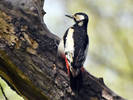search
classification
|
basic information
|
video
|
White-Winged Woodpecker
Dendrocopos leucopterus (Salvatori, 1870)

|
 male
|
|
|
2021-05-17
Chui region, Kemin |
© Nurzhan Alymkanova
|
|
Description
Male on breeding plumage seems more piebald than Great Spotted Woodpecker at the expense of larger white patches on scapulars. Forehead is cream color, crown is black metal-glossed, on the nape there are rather narrow red spot. Mantle, rump and uppertail coverts are black; cheeks are white bottom-bordered by the black strip reached to nape and forked in a back part of a head, one branch reaches to the breast, another one to the nape. The flight feathers are blackish-brown but in the end of the breeding season become lighter owing to fading. The flight feathers are with white spots on webs width up to 8-12 mm. On inner webs these spots almost reach the feather core (start with PM4). On secondaries white spots merge. The tail feathers are black, two central pairs are wedge-shaped and longer than outer one on 15-20 mm; the outer feathers have brown and white spots on webs. The throat and the breast are white, the abdomen and undertail coverts are bright red. The female is similar to male, but slightly smaller and without red spot on nape. Dark color of plumage of female is slightly paler than at male. Juveniles in the first plumage have on head the golden-red crown and more pale plumage. Unlike adults primaries of juveniles have white tips width of 2-2,5 mm. Throat and breast are dirty-white. Uppertail reddens later than at juveniles of Great Spotted Woodpecker; anyway at the end of July it has only pale-yellow color. They also have less or lack dark streaks on flanks and breast. Generally very similar to Great Spotted Woodpecker, features a large of white on the folded wing.
Biology
Rare resident. Inhabits the riparian and saxaul plain forests, groves, old shelterbelts. On Pskem and Ugam ridges lives in gardens and mixed walnut forests on valleys, at altitudes up to 2000 m. Breeds in separate pairs at distance 300-500 m one from another, nest is located in tree holes (asiatic poplar, willow, apple-tree, elm, walnut or saxaul) at height 0.5-5 m above the ground. Clutch of 4-5 eggs is laid in mid-April to mid-May. Both parents incubate clutch and fed juveniles, which fledge in end June to early July. Broods with parents recorded until September. Re-nesting after loss of first clutch is common.
References
«Птицы Казахстана» под редакцией И.А.Долгушина. том 3. изд. АН КазССР. Алма-Ата - 1970. Gavrilov E. I., Gavrilov A. E. "The Birds of Kazakhstan". Almaty, 2005. Э.И.Гаврилов. "Фауна и распространение птиц Казахстана". Алматы, 1999.






